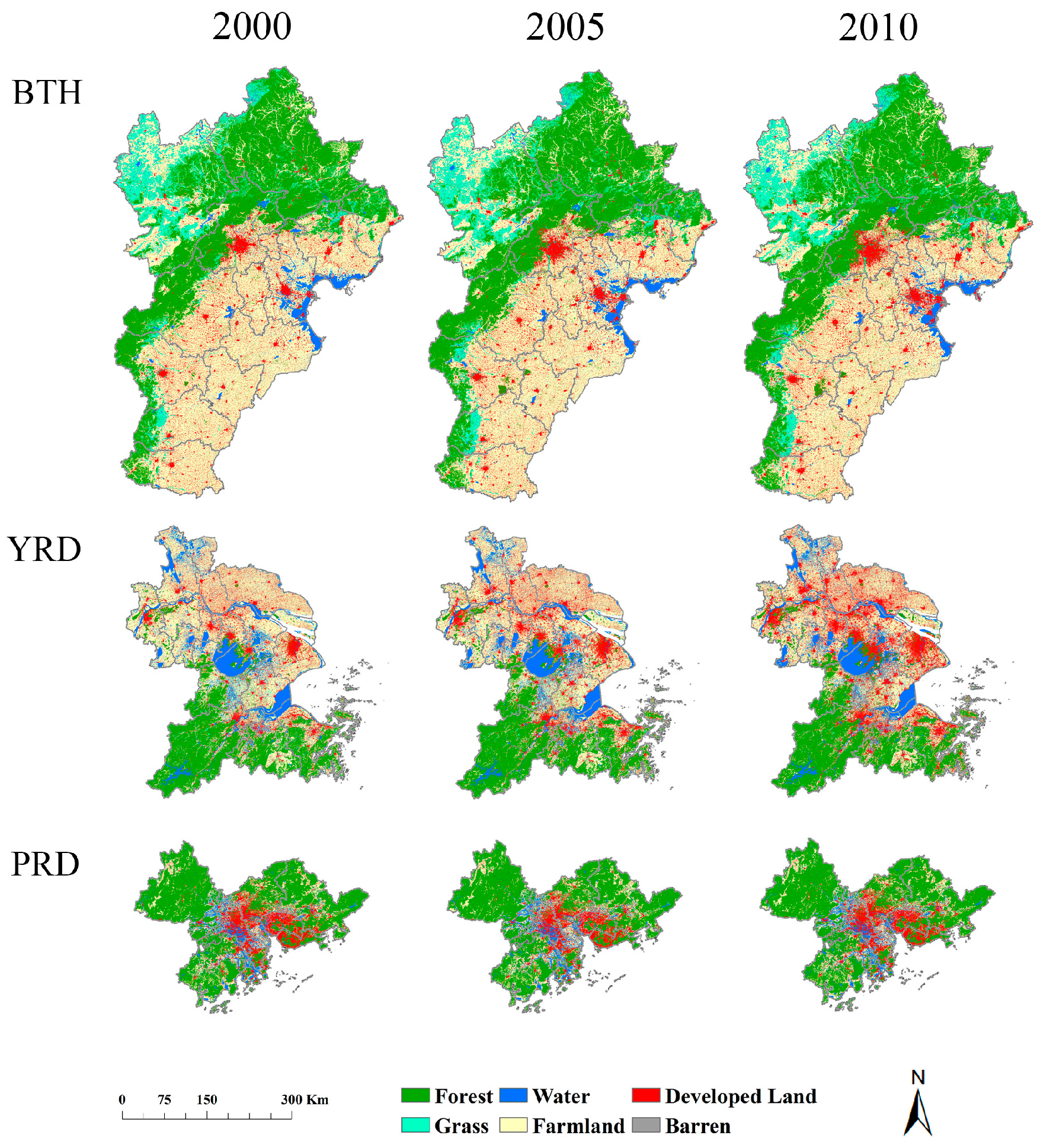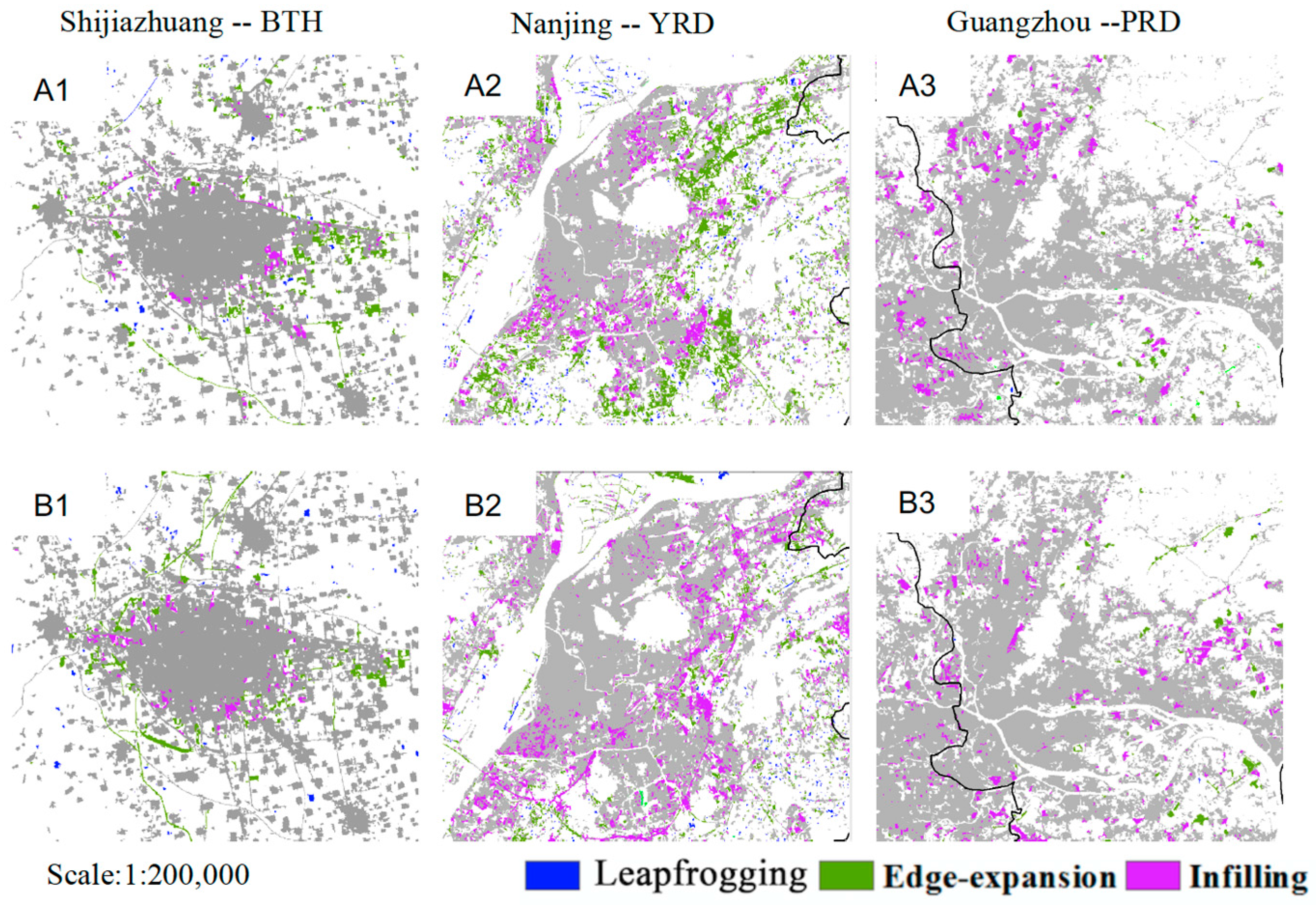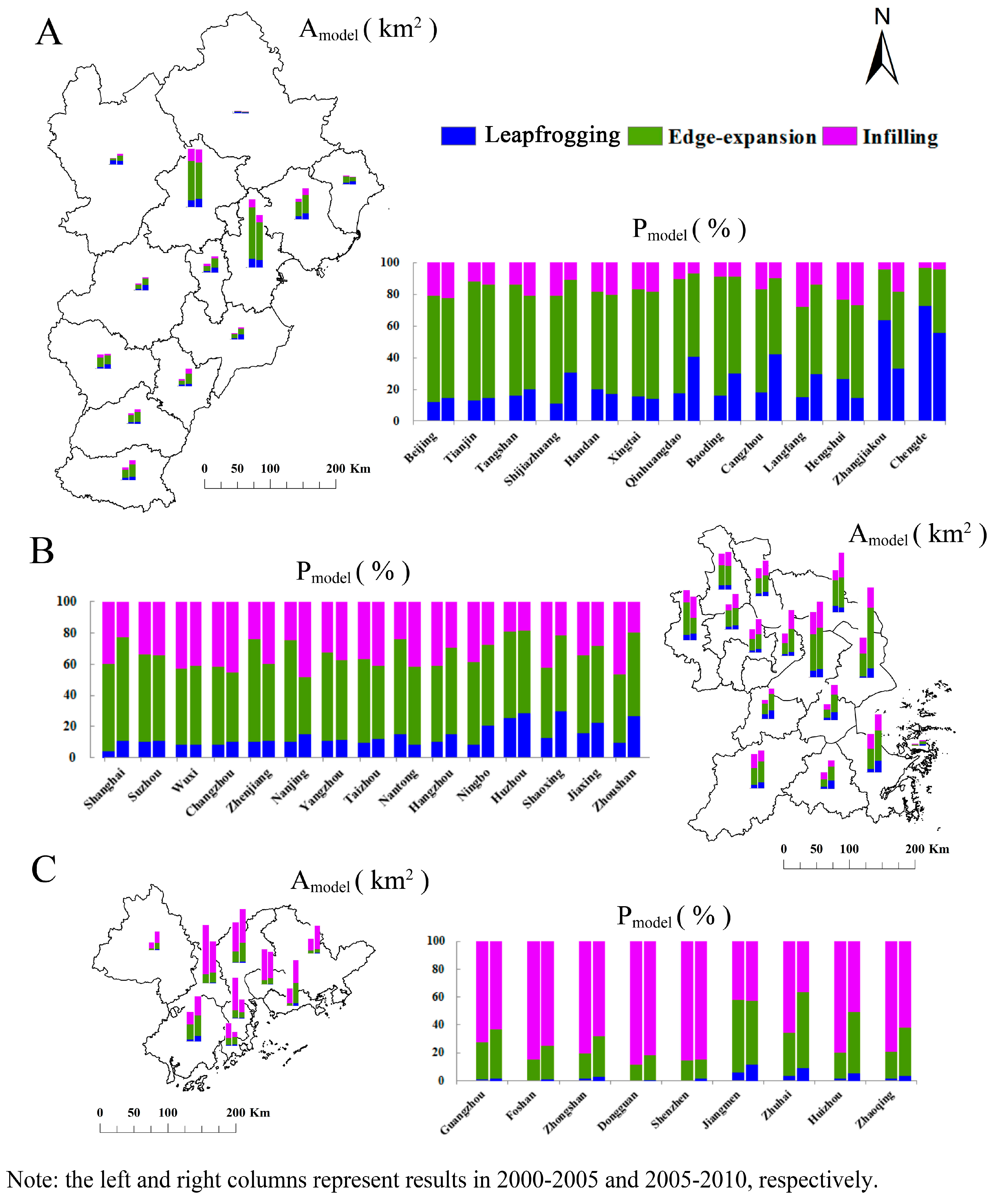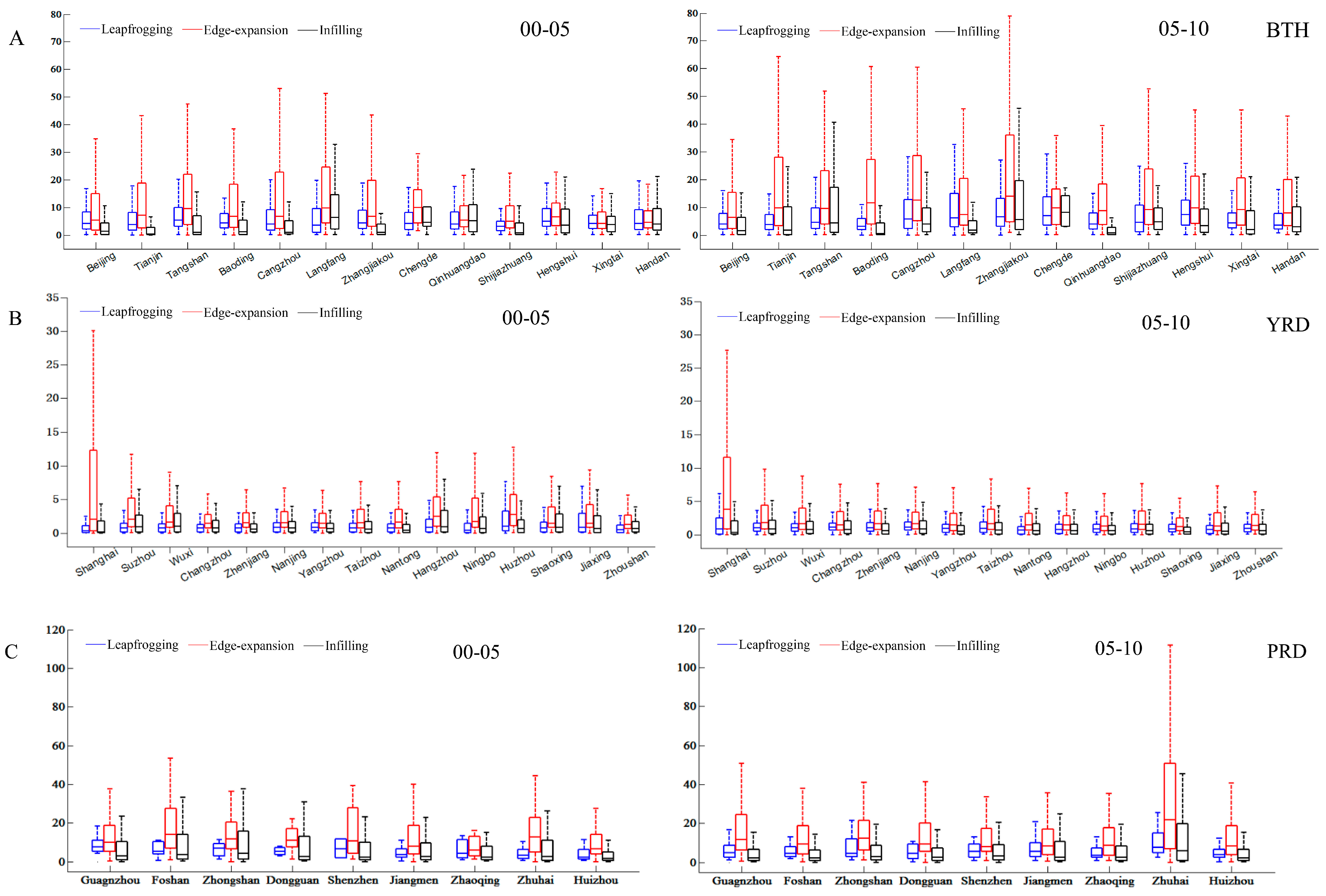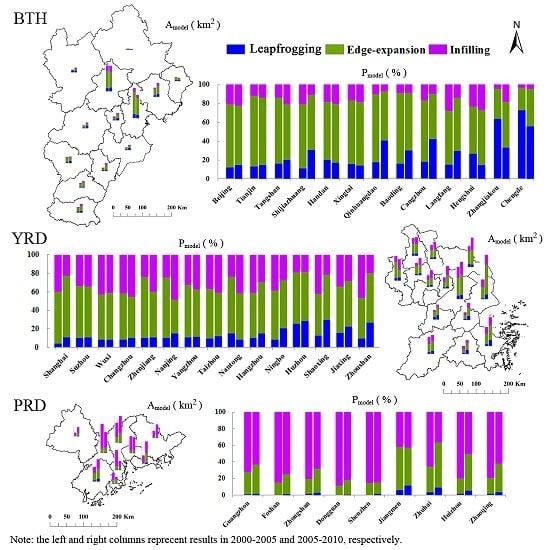1. Introduction
Urban expansion drives the conversion of landscapes and causes a massive of environmental and ecological impacts [
1,
2,
3,
4,
5]. These impacts occur not only within the urban area itself but also well beyond the urban boundaries [
1,
2,
3]. In fact, urbanization is increasingly becoming a major driving factor of landscape changes and environmental issues at the regional scale [
6,
7]. To better understand how regional urbanization affects the environment, the spatiotemporal pattern of urban expansion and its driving forces must be first quantified [
8,
9,
10].
A considerable number of studies have been conducted to quantify spatiotemporal pattern of urban expansion. The focus of these studies includes: (1) the extent and speed of urban expansion [
11,
12]; (2) landscape pattern and changes along the resultant urban-rural gradients, frequently quantified by landscape metrics [
13,
14]; and (3) the morphology of urban expansion, such as urban sprawl versus compactness [
15], models of urban expansion [
16]. Recognizing the importance of urban morphology for environmental and ecological issues [
17,
18], there is an increasing interest in quantifying the models of urban expansion [
17,
19,
20,
21].
There are three types of models, namely, leapfrogging, edge-expansion, and infilling, which are widely recognized for portraying the morphology of urban expansion [
16,
19,
20]. Specifically, leapfrogging refers to the model in which new patches of developed land are not adjacent to existing patches of developed land; edge-expansion represents the pattern in which new patches of developed land grow out of the fringe of existing patches of developed land; and infilling refers to the pattern in which new patches of developed land are surrounded by existing patches of developed land [
16]. Based on the pattern of expansion models, the city develop can be summarized as a process that shifts from one of diffusion to one of coalescence [
17,
20].
Remote sensing data have been widely used for urban expansion studies, as these data provide both spatial detail and temporal frequency for urban morphology and change. Particularly, the historical information revealed by multi-temporal remote sensing data is important for quantifying the process of urban development [
22,
23]. Among the numerous available remote sensing data, the Landsat image, including MSS, TM/ETM+ and OLI, is one of the most widely used data for urban expansion [
24,
25]. Integrating remote sensing data with landscape urban analysis is particularly useful for understanding the spatiotemporal patterns of urban expansion [
26,
27].
Numerous studies have been conducted to investigate the spatiotemporal pattern of urban expansion for cities such as Nanjing [
19], Lianyungang [
28] and other major cities [
12,
29,
30] from China, Phoenix and Las Vegas from the USA [
26], and 25 global cities [
15]. These studies that focused on the spatiotemporal pattern of urban expansion have been largely conducted in a single city [
19,
28] or in several cities for comparison purposes [
12,
15,
26,
29,
30]. In addition, most of these studies have focused on large cities. Few studies, however, have been conducted at the regional scale that include cities of different sizes [
20]. Globally, urban megaregions have emerged as a new form of urbanization [
18,
31,
32]. Urban megaregions physically cover not only the spatially proximal urban areas with different scales but also the intervening suburban and exurban regions, which are linked by social processes, including population migration, development policy initiatives and lifestyle changes [
31,
33,
34]. Therefore, taking urban megaregions as examples, understanding urban expansion at the regional scale that includes cities of various sizes is important for extending current knowledge of urban growth, and therefore, its environmental and ecological impacts.
Here, we chose the three largest urban megaregions in China, the Beijing-Tianjin-Hebei (BTH), Yangtze River Delta (YRD), and Pearl River Delta (PRD), as our study areas. We addressed the following two questions: (1) What are the spatiotemporal patterns of the extent, rate, and morphological model of urban expansion at both the regional and city scales in the three urban megaregions; and (2) How do factors such as geographical locations, the size of the city and its expansion rate influence the model of urban expansion? We first quantified and compared the spatiotemporal patterns of urban expansion from 2000–2010 at both the regional and city scales based on remote sensing data. We then examined how factors such as the size of the city and its expansion rate influenced the model of urban expansion using correlation analysis and linear regressions.
2. Materials and Methods
2.1. Study Area
The Beijing-Tianjin-Hebei (hereinafter refereed to the BTH), the Yangtze River Delta (YRD) and the Pearl River Delta (PRD) are the three biggest urban megaregions in China. The three megaregions are located in the eastern coastal region, the most densely populated area in China, and are distributed from north to south. In our study, the BTH urban megaregion includes Beijing and Tianjin, two municipalities directly under the Central Government, and the Hebei province. The YRD urban megaregion contains the municipality of Shanghai, southern Jiangsu Province and northern Zhejiang Province. The PRD includes nine cities of Guangdong Province (
Figure 1).
The BTH encompasses approximately 215,800 km2, with a total population of 110.53 million in 2014 (approximately 8.08% of the total population of China), and the gross domestic product (GDP) of 6647.90 billion Yuan, accounted for 10.45% of the GDP in China (National Bureau of Statistics of the People’s Republic of China, 2014). The terrain in the BTH is high in the northwest but low in the southeast, with the Taihang and Yan mountains to the northwest and the Northern China Plain in the southeast. The elevation of BTH ranges from 50 m to 2832 m. The YRD urban megaregion covers an area of 103,960 km2. At the end of 2014, the total population in this region was 98.38 million and the GDP was 7523.05 billion Yuan, accounting for 7.19% of the total population and 11.87% of the total GDP in China, respectively (National Bureau of Statistic of China, 2014). The geomorphology in this region characterized by the Yangtze River alluvial plain in the northern part and rolling hills in the southern part, resulting in a generally low terrain. The PRD covers nearly 54,000 km2, with the total population of 57.63 million in 2014 (approximately 4.21% of the total population of China), and the GDP of 5765.00 billion Yuan (about 9.09% of the total GDP in China; Guangdong Provincial Bureau of Statistics, 2014). In the PRD, the undulating hills and the confluence of three large rivers are the defining geomorphological features of this delta region.
2.2. Data
The spatiotemporal patterns of urban expansion were quantified based on land use and land cover (LULC) classification maps of 2000, 2005 and 2010. Six types of land cover were included: forest, grass, water, farmland, developed land and barren. The class forest includes deciduous forests, evergreen forests, mixed forests and shrubs. The class grass includes areas dominated by grassland and herbaceous vegetation. Water includes rivers, lakes, reservoirs and ponds. Farmland consists of paddy fields and dry lands. Developed land includes urban and rural residential, commercial, industrial and transportation lands. Barren includes bare soil and sand. The classifications were derived from Landsat TM imagery with 30 m spatial resolution, using an object-based backdating approach [
35]. The LULC map of 2010 was first generated by an object-based image analysis method, using Landsat TM imagery collected in 2010. The 2010 LULC map was then used as a reference map to generate the maps of 2005 and 2000, using an object-based backdating approach [
35]. Taking 2005 as an example, the objects with change were first extracted by change vector analysis, and the land cover types of these objects in 2005 were then identified. The objects with no change were backdated as the land cover type of 2010. The LULC classification map of 2000 was also generated by the same procedure (
Figure 2). In addition, extensive manual editing was performed to refine the classifications by visually referencing to very high-resolution imagery, including 2.4 m QuickBird and 2.5 m SPOT 5 imagery. The overall accuracy of these three LULC classification maps was over 96%. More details about the classification approach can be found in Yu et al. (2016) [
35].
2.3. Typological Quantification for Urban Expansion
Based on the LULC classification maps, we identified the newly developed land during the two-time periods, that is, 2000–2005 and 2005–2010. This was done by overlapping analysis using LULC classification maps from two years. We further classified the newly developed land into three spatial expansion models—leapfrogging, edge-expansion, and infilling—by following the methods detailed in Xu et al. (2007) [
19] and Li et al. (2013) [
20]. Specifically, the equations below were used to classify patches of newly developed land:
where
Lc represents the shared boundary between a newly developed patch and the previously developed patch(es), and
P is the perimeter of the newly developed patch. The spatial expansion models are classified based on the value of
S, as specified above.
The LULC classification maps generated by the object-based backdating approach greatly reduce errors on the identification of expansion models. These included isolated patches that were assigned as leapfrogging, but in fact were generated by “salt and pepper” noises. In addition, errors that the sliver patches generated by imagery misregistration were typically classified as edge-expansion were largely reduced. Therefore, the LULC classification approach used in this study is crucial for the typological quantification of urban expansion.
2.4. Statistical Analyses
We used three indicators to quantify and compare the magnitude, relative speed and morphology of urban expansion at both the regional and city scales for the three urban megaregions (Equations (3)–(5)). Specifically, we calculated the area of newly developed land (Equation (3), A
new) to measure the magnitude of urban expansion. The ratio (Equation (4), P
new), calculated by dividing the area of previously existing developed land by the total area of newly developed land, was used to measure the relative speed of urban expansion. Here, we used a ratio, the P
new, to measure the relative speed by accounting for the area of newly developed land relative to the size of the city. Therefore, we could compare the urban expansion speed across cities with different sizes. For the expansion morphology, we calculated the total area, percentage (Equation (5), P
model) and patch size distribution for each of the three expansion models.
where A
t1 and A
t2 represent the total areas of developed land at the prior year (t
1) and posterior year (t
2), respectively. A
staring represents the area of previously existing developed land and A
model is the area for each of the three expansion types. Boxplots were used to investigate the size distribution of patches with different types of urban expansion models.
We furthermore examined the effects of city’s characteristics on urban expansion models by a linear-regression method. We chose five typical characteristics as predictors, including city’s location in a particular megaregion, size of city, relative speed of urban expansion, permanent residential population and the percentage of GDP of the tertiary industry or service economy to the total GDP (
Table 1). These predictors were selected based on results from previous studies [
36,
37,
38]. As geographical location is a categorical variable, we set the BTH as the reference (i.e., dummy variable), and used nominal variable to distinguish the city location in the YRD and PRD.
Before running the linear-regressions, we examined the strength of bivariate associations between the variables using the Pearson correlation matrix. Results showed that the variables of population and the size of city had a high value of the correlation coefficient, 0.830 and 0.824, in 2000–2005 and 2005–2010, respectively. In addition, the population also had Pearson correlation with the GDP percentage of the tertiary industry, with the value of 0.453 and 0.462. Therefore, the variable of population was not included in the regression model (
Table 2).
4. Discussion
Our results showed that the extent, rate and morphological model of urban expansion varied greatly by urban megaregions and cities. We found larger cities tended to have more newly developed land and develop at a relatively rapid rate, which is consistent with findings from previous studies [
12,
25]. We also found that in the YRD megaregion, the smaller cities had larger annual rates of urban expansion, which is similar to some Asian cities that had small size but experienced more rapid urbanization [
39,
40,
41]. Similar to the results at the city scale, at the regional scale, the two urban megaregions, YRD and PRD that had higher proportional cover of developed land in 2000, and expanded more rapidly than the BTH megaregion from 2000–2010 (
Table 3). The difference in magnitude and speed of urban expansion at the regional scale are likely due to the regions being in different phases of urban growth, in combination with the different terrain and geomorphology of the three urban megaregions [
37,
42,
43].
Population and the size of city had strong positive correlation revealed by the Pearson correlation analysis, suggesting the size of city increased with the growth of population in 2000–2010 (
Table 2). Previous studies have showed that the residential population mostly had a significant increase trend at the city level from 2000–2010 across the nation [
44,
45], along with increase of developed land [
46,
47]. These correlations generally support some previous findings that urban expansion is largely driven by population growth [
46,
47].
As for morphological models of urban expansion, small-sized cities were more likely to develop in a leapfrogging model, while cities with relatively rapid expansion tended to grow in an edge-expansion model (
Table 6). These results suggested that the expansion of the cities of the three urban megaregions also followed the “diffusion and coalescence” hypothesis [
17,
19,
28]; that is, in the early stage of urban expansion, leapfrogging generally is the dominant model, while the edge-expansion model dominates in the rapid expansion stage, and infilling becomes the major mode of expansion in the stable stage. When a city is in its early stage, numerous new towns are built, resulting in a lot of leapfrogging patches. After that, the city is likely undergone rapid expansion, typically associated with a fast increasing of outward expansion from the previously created leapfrogging patches. Lately, these growing patches merge with the neighbor ones, and become larger edge-expansion patches. Consequently, following the expansion processes, the city size mostly had the negative effect on the leapfrogging model, and relative speed had positive effect of edge-expansion type (
Table 6).
At the regional scale, the dominant type of morphological models of urban expansion were different among the three urban megaregions. The two relatively well-developed urban megaregions, YRD and PRD, were dominated by expansion of infilling, while the BTH was still dominated by edge-expansion. Therefore, similar to cities, expansion in entire urban megaregions also followed the “diffusion and coalescence” processes, even though the urban megaregions consisted of cities in different phases of individual-city diffusion/coalescence development. Additionally, the differences in the patch size of newly developed land among cities having different sizes in the same urban megaregion became smaller, indicating that urbanization at the regional scale tends to homogenize patch dynamics of the developed landscape (
Figure 6A–C). These results, though at the regional scale, were consistent with findings from previous studies that were conducted at the city scale, showing that patch structure of the landscape becomes similar with urban megaregion development [
12,
48,
49]. As previous studies have been mostly conducted at the city scale, our results can enhance understanding on how urbanization may lead to homogenization of urban landscapes at the regional scale.
Except for a few cities in the PRD urban megaregion, cities in the three urban megaregions were mostly dominated by growth of edge-expansion and leapfrogging, which may be linked with urban sprawl, or low land efficiency [
15,
50]. It is widely recognized that urban sprawl may lead to not only environmental and ecological issues (e.g., loss of open space and wildlife habitat, increased surface runoff and flooding, and air pollution) but also social problems and health issues (e.g., increased expenditure in public services and thus taxes, increasing traffic congestion and obesity [
51,
52,
53,
54]. Therefore, whether and how these different types of morphological models or urban growth affect the environmental and ecological quality warrants further research.
In this study, we only focus on the spatiotemporal pattern in 2000–2010 based on LULC maps of three time slices (i.e., 2000, 2005, and 2010). It would be interesting to have longer term observation on the developedment of urban megaregion. Additionally, the identification of urban expansion morphology will be affected by the interval of data collection/observation. The size and the expansion model of the newly developed land patches may change when uesing datasets with different time-interval. For example, a patch is identified as leapfrogging when using data from two adjecent year, but may be classified as edge-expansion if using data with five-year interval. Therefore, it would be interesting to explore the method for spatiotemporal pattern of urban expansion.
5. Conclusions
Urban megaregions have emerged as a new form of urbanization. However, previous studies have mostly focused on urban expansion at the city scale, particular large cities. Here, we focused on the three largest urban megaregions in China, Beijing-Tianjin-Hebei (BTH), the Yangtze River Delta (YRD) and the Pearl River Delta (PRD), and investigated how the extent, rate, and morphological model of urban expansion varied at both the regional and city scales. Furthermore, we indicated how factors such as the locations, the size of the city and its expansion rate influenced the model of urban expansion.
We found that (1) the three urban megaregions experienced very rapid and massive urban growth but the spatiotemporal pattern of urban expansion varied greatly. The most well-developed megaregion, the PRD, had the highest proportion of infilling type of urban expansion. The PRD was dominated by peri-urban infilling and edge-expansion distributed across the towns close to the cities, representing an intermediate development model. The BTH, especially the Beijing-Tianjin corridor, however, had lots of big new towns mostly resulted in leapfrogging development, representing the initial expansion stage. The patch structure of the landscape of the cities having different size in the same urban megaregion tend to be homogenized along with the regional urbanization; (2) The size of a city and its expansion rate also affected the model of urban expansion. Small-sized cities were more likely to develop in a leapfrogging model, while cities with relatively rapid expansion tended to grow in an edge-expansion model.
The findings from our study reveal the urban growth process in urban megaregion. It provides not only the reference for those regions that have potential to be urban megaregions, but also supports for urban megaregion planning and management. As urban morphology closely relates to some environmental and ecological issues, we also recommend future research to investigate whether and how these different types of morphological models of urban growth affect land use efficiency, and environmental and ecological quality.

